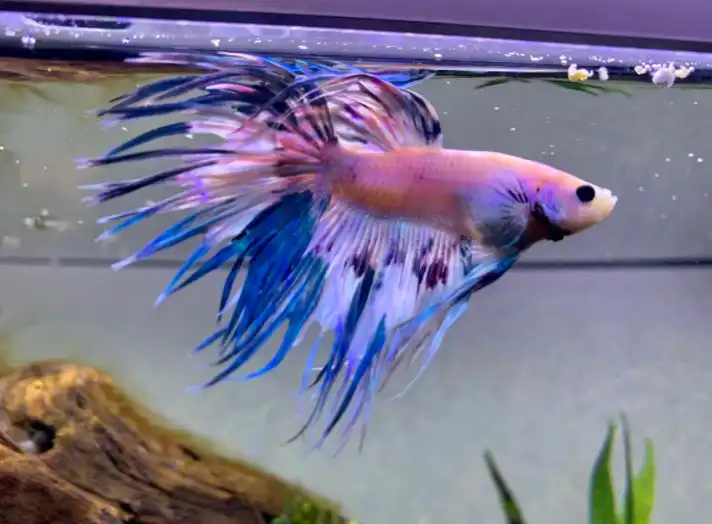How to treat velvet in Betta fish?
Velvet disease, also known as “golden algae,” is a parasitic infection caused by the protozoan Piscinoodinium. The velvet parasite is classified as a Parasitic algae because it contains chlorophyll, which allows it to obtain energy through photosynthesis.
It also feeds on the host fish’s blood cells, causing damage to the Betta fish’s fins, gills, and skin. The infection is characterized by small yellowish spots on the Betta fish’s body, much smaller than those typically seen in Ichthyophthirius multifiliis (ich) infections.

The infected betta fish may also exhibit clamped fins, flashing off surfaces, and rapid respiration or gasping for air at the surface, significantly if the gills are affected.
Table of Contents
- Can I use copper sulfate for velvet betta fish?
- A list of Betta fish Velvet disease Common Signs
- Quarantine and start treatment for velvet betta fish
So to prevent a velvet outbreak, it is often recommended to reduce the lighting in the tank, as the velvet parasite requires visible light to survive.
Always need to remember the velvet parasite, Piscinoodinium, has two distinct life stages:
01. Free-swimming trophont
02. Cyst
So the trophont stage is the infective stage of the parasite, during which the parasite uses its two flagella to move through the water, actively searching for a suitable host fish.
Once a host is found, the trophont attaches itself to the Betta fish’s skin or gills and feeds on the host’s blood cells.
After a while, the trophont will develop into a cyst, which remains attached to the Betta fish’s skin or gills. The cyst will then release several hundred free-swimming Piscinoodinium, actively searching for new host fish to infect, continuing the cycle.
The velvet parasite’s ability to infect multiple fish in one tank and the rapid release of infective trophonts from the cyst stage make velvet disease highly contagious among fish populations.
tiny fish tank
Can I use copper sulfate for velvet betta fish?
Always remember that Velvet disease can be effectively treated using copper sulfate, considered the most effective treatment option.
But, it is essential to note that copper sulfate is also toxic to invertebrates, such as snails and shrimp, and should not be used in tanks containing these species.
As you know, it is crucial to use copper sulfate according to the manufacturer’s instructions and to avoid over-dosing, as this can cause harm or death to the fish.
When you use it, and after the treatment, it’s important to gradually change the water to remove all traces of the copper sulfate. Another benefit of using copper sulfate is that it can also effectively kill the ich parasite, if present, making it a versatile treatment option for external fish parasites.
It would be best to remember that copper sulfate will only affect the free-swimming trophont stage of velvet disease, while the encysted stage is not vulnerable to treatment.
Another alternative treatment option is using products with Acriflavine as an active ingredient, which may cause infertility.
A list of Betta fish Velvet disease Common Signs

- Small yellowish spots on the fish’s body and fins
- Clamped fins
- Flashing off surfaces
- Rapid respiration or gasping for air at the surface
- Loss of appetite
- Loss of color
- Increased lethargy and listlessness
- Irregular swimming patterns
- Discoloration of the gills
- Secondary bacterial or fungal infections
- Ulceration or hemorrhages on the fish’s skin
- Loss of scales
- Swelling of the body
- Thickening of the skin
It’s important to note that other diseases or stressors can also cause these signs, so it’s essential to consult with a veterinarian or an experienced aquarist for an accurate diagnosis.
Read More About :- How to tell if Betta fish is stressed?
Quarantine and start treatment for velvet betta fish
Always keep in your mind; A quarantine aquarium is a valuable tool for preventing the spread of disease among fish populations and can be set up quickly and inexpensively.

Many fish hobbyists already have the necessary equipment, such as,
- 10-gallon fish tank
- Sponge filter
- Heater
- Indian Almond Leaf
- Plastic flowerpots or PVC pipes provide hiding places for the Betta fish.
As you know, larger aquariums may be necessary for keeping larger freshwater species. Maintaining excellent water quality in the quarantine aquarium is essential, including maintaining proper pH and low nitrogenous waste levels.
You can buy a well-established sponge filter with a culture of beneficial bacteria, such as Nitrosomonas and Nitrobacter, to help keep ammonia and nitrite levels at zero. However, frequent water changes may still be necessary to maintain proper nitrate and pH levels.
It is crucial to be consistent with the water parameters, such as pH and temperature, during water changes to avoid further stress on the fish.
| Medicine/Treatment | Instructions to use the medicine |
| Copper Sulfate | Add to the water at a specific concentration and for a particular duration according to the manufacturer’s instructions. Gradually change the water after treatment to remove all traces of the copper sulfate. |
| Formalin | Add to the water at a specific concentration and for a particular duration according to the manufacturer’s instructions. Gradually change the water after treatment to remove all traces of the Formalin. |
| Acriflavine | Add to the water at a specific concentration and for a particular duration according to the manufacturer’s instructions. Gradually change the water after treatment to remove all traces of the Acriflavine. |
| Saltwater Bath | Keep the fish in a saltwater bath (3-5 parts per thousand) for a specific duration. Gradually acclimate the fish back to freshwater after treatment. |
Always Quarantining betta fish for 21 to 45 days is a widely accepted practice for preventing the introduction of parasites into the main aquarium. During this time, regular water changes can help to eliminate parasites by dilution and minimize the risk of reinfection.
Some Fish keepers also recommend keeping Betta fish in saltwater during quarantine, as this can help to eliminate pathogens that are not salt-tolerant and also aid in maintaining the fish’s fluid balance.
While antibiotics are not always necessary, some aquarists may use a wide-spectrum antibiotic or Formalin for fish that show early signs of disease.
When you use Formalin, in particular, is effective in eliminating protozoan parasites. It’s essential to remember that this approach is not without risk as Formalin can be toxic to fish and invertebrates, and also note that some parasites like ich can be resistant to Formalin.
Read More About :- https://www.tinyfishtank.com/can-betta-fish-live-in-hard-water/







